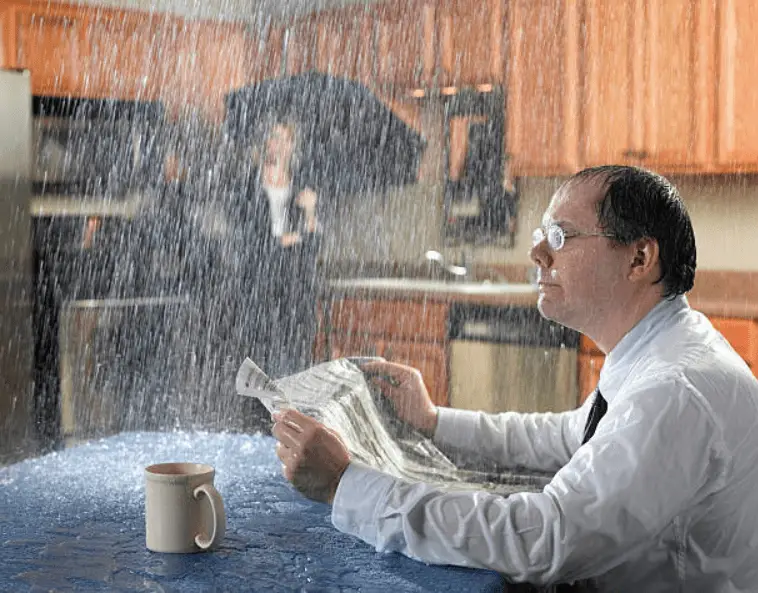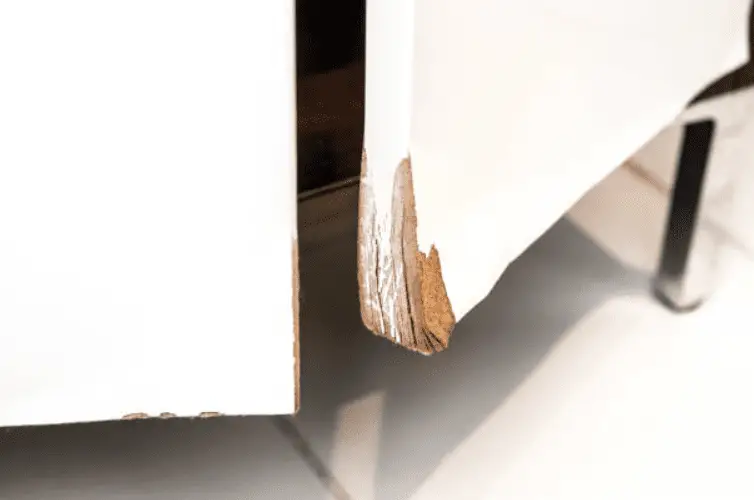You may have a favorite piece of furniture that’s made of wood, which you show off and boast about each time you have guests over.
Or an outdoor wood deck. Something that you really admire.
How heartbreaking it is going to be if it’s succumbed to damage?
A small leak, rain, indoor flooding, or whatever is the culprit behind such damage, we can understand the position you are in now.

In this post, we are going to help you with some DIY – damage control measures to fix water-damaged furniture.
Now, let’s talk basics before getting into the business of fixing water-damaged furniture.
What Is The Impact of Water Content On Wood?

Water or moisture content can cause damage to the wood in different ways. Not every wood responds to humidity in the same manner. It depends on the dimensional structure of the wood.
Hardwoods tend to have much more water resistance than softwoods. However, prolonged contact with water can still cause damage to any wood.
Water deteriorates the wood and may cause it to:
- Bends In Wood: Wood absorbs water and swells, which causes it to warp or bend. This can lead to wood splitting or cracking and make it challenging to open and close windows and doors.
- Rot: Lignin, cellulose, and hemicellulose make up wood. The cellulose and hemicellulose in the wood can degrade in the presence of water, resulting in rot. Rot can make the wood more brittle and breakable by weakening its structural integrity.
- Growth of Mold: Water can also promote the development of mold and mildew on wooden surfaces. This can taint the wood, produce an offensive odor, and pose a health risk if inhaled.
- Insect or Other Pest Infestation: Wet wood is more prone to termites or other pest infestations, such as carpenter ants. This could further harm the timber and endanger the stability of the furniture/deck.
How To Address Damaged Caused By Water To Wood?
The first step to addressing water damage is to inspect the wood.
This helps you in understanding the depth and the seriousness of the damage and you can figure out how to tackle the issue as the next step. These damages can be manifested in various forms.
Wood that has been impacted by water may show signs:
1. Water Stains or Discoloration
Water stains are a clear indication that water damage has occurred. They often appear as dark, discolored patches on the wood.
If you are inspecting water damage to your wooden floors, pay close attention to corners and areas where walls and ceilings meet. These areas can be particularly susceptible to water damage, as they are often harder to access and may be overlooked during routine inspections.
Additionally, they can be any color, ranging from yellow to brown, black, or even green. They can also resemble water rings or patches, and occasionally they may even have a musty smell.
2. Change in The Shape or Structure
When it comes to the floor, it may become soggy and even sink or buckle. Another major sign of water damage is when the boards begin to rise up like a tent, indicating that the inner structure has been compromised.
Wooden furniture can also sustain water damage, with frequent problems including swelling and sogginess. The furniture may break apart due to the wood’s potential to change in texture and damage to the glue or binding holding it together.
As a result, the furniture may become unstable and dangerous to use. The furniture may also start to look ugly and discolored.
3. Mold Growth

You can spot mold or mildew growth on your wood from water damage. This can be seen in black or furry patches.
The presence of mold should be taken seriously. It can cause health hazards. This can be in the form of respiratory infections, asthma, or allergic reaction.
How To Fix Water-Damaged Wood?
Now, let’s talk about fixing the water-damaged wood. As the first step, you can find out the root cause of the problem and see if you can eliminate it.
It might be necessary to install a dehumidifier, increase ventilation, or address leaks. Any moist areas must be dried up as quickly as possible to avoid further harm.
Once you have found and fixed it, you can proceed with fixing the wood.
4-Step Guide To Fix Water-Damaged Furniture
Use the below steps to fix any furniture that got damaged due to moisture & water damage:
1. Remove The Damaged Part:
Let’s face it! You may not be able to save all of it. Put on your gloves and inspect the whole wood/floor.
Remove the unsalvageable parts. This might entail chopping off chunks of wood.
To ensure that the repair is successful and to stop the growth of mold, it is crucial to remove all damaged wood.
2. Clean The Wood:
Before proceeding to the major steps, make sure that you properly clean the wood.
To clean the wood, mix two caps of bleach with half a bucket of warm water. Next, add three caps of mild dishwashing soap and stir the mixture.
The bleach will help to kill any mold and mildew, while the dishwashing soap will help to remove dirt and debris. Use a scrub brush to scrub the furniture thoroughly, paying special attention to areas of mold and mildew.
Be sure to work the solution into the wood and all the surfaces, including the crevices, legs, joints, and corners.
After scrubbing, rinse off the soap with water, and repeat the steps if necessary. Be sure to rinse thoroughly, remove all the cleaning solution, and ensure that no residue is left on the wood.
Allow the wood to thoroughly air dry after cleaning. To avoid warping or cracking, never use heat to dry anything. To avoid the regrowth of mold and mildew, it is crucial to let the wood dry fully.
3. Strip The Paint & Finish:
This can be achieved by sanding the wood.
The first step in sanding water-damaged furniture is to put on a dust mask to avoid inhaling wood dust. This is important because inhaling wood dust can be harmful to your health and can cause respiratory problems.
Next, use a sander with 220-grit sandpaper to sand the furniture in the direction of the grain. Remember to focus on the water-damaged areas first, as these areas will need the most attention. Continue sanding the remainder of the furniture to create an even layer.
Remove the wood dust using a clean paintbrush. This will help to prevent the wood dust from settling on the furniture and causing further damage.
Then, use a clean paintbrush to apply a chemical stripping agent to the wood. This will help to remove any remaining stains or discolorations caused by the water damage.
Wait for the chemical agent to oxidize or bubble, as this is a sign that it is working. Take a putty knife to scrape the surface of the furniture to remove the loosened material.
Then, use 100-150-grit sandpaper to remove the excess stripping agent.
As the last step, use a clean paintbrush to remove the excess wood dust. This will help to ensure that the surface of the furniture is clean and smooth.
4. Varnish & Finish/Seal It Off:
Your wooden work may have regained most of its pre-damaged structure by now. You can finish the work by varnishing it.
If you wish to, you can paint the furniture first and then use the varnish. Use a water-repellent varnish this time.
Once the paint has dried from the previous step, apply the first coat of varnish to your wooden furniture. This can be done using a brush or roller, depending on the size and shape of the furniture. It is important to apply the varnish evenly to ensure that the entire surface is covered.
After the first coat has dried, which usually takes around 24 hours, apply a second coat. This will help to build up the protective layer and ensure that the furniture is fully sealed. It is important to allow the second coat of varnish to dry completely before using the furniture again.
It is important to note that applying varnish is a process that requires patience and attention to detail.
It is important to read the manufacturer’s instructions and follow them carefully to ensure that the varnish is applied correctly and that the furniture is protected.
Can You Prevent Water Damage?
Going through all these hectic resurrection steps might have made you pause and think for a moment about water damage prevention.
You wouldn’t definitely want to repeat the whole process a few months/years down the road.
If the wood is for outdoor use, make sure to use the right wood from the start itself. So as to protect the wood from water damage, you can use waterproof coatings that go along with the type of wood that you are using.
If it is indoor, make sure that the wood gets proper ventilation and airflow. Regular inspections and maintenance can also help to increase the longevity and preserve the appearance & beauty of the wood.
Conclusion
In conclusion, applying a waterproof and insect-repellent varnish to wooden furniture is an effective way to protect it from water damage and insect infestation.
It is important to choose a varnish that is specifically designed for use on wooden furniture, and to apply it in multiple thin coats, allowing each coat to dry before applying the next.
With proper application and care, the varnish will provide a long-lasting protective barrier for your wooden furniture, keeping it looking beautiful for years to come.
